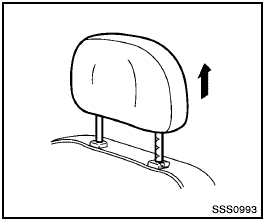 Nissan Rogue: Head restraints
Nissan Rogue: Head restraints

Head restraints supplement the other vehicle safety systems. They may provide additional protection against injury in certain rear end collisions. Adjust the head restraints properly, as specified in this section. Check the adjustment after someone else uses the seat. Do not attach anything to the head restraint stalks or remove the head restraint. Do not use the seat if the head restraint has been removed. If the head restraint was removed, install and properly adjust the head restraint before an occu- pant uses the seating position. Failure to follow these instructions can reduce the effectiveness of the head restraints.
This may increase the risk of serious injury or death in a collision.

The illustration shows the seating positions equipped with head restraints. The head restraints are adjustable.
 Indicates
the seating position is equipped
with a head restraint.
Indicates
the seating position is equipped
with a head restraint.

Components
1. Head restraint
2. Adjustment notches
3. Lock knob
4. Stalks

Adjustment
Adjust the head restraint so the center is level with the center of your ears.

To raise the head restraint, pull it up.

To lower, push and hold the lock knob and push the head restraint down.

Removal
Use the following procedure to remove the adjustable head restraints.
1. Pull the head restraint up to the highest position.
2. Push and hold the lock knob.
3. Remove the head restraint from the seat.
4. Store the head restraint properly in a secure place so it is not loose in the vehicle.
5. Install and properly adjust the head restraint before an occupant uses the seating position.

Install
1. Align the head restraint stalks with the holes in the seat. Make sure that the head restraint is facing the correct direction. The stalk with the adjustment notches 1 must be installed in the hole with the lock knob 2 .
2. Push and hold the lock knob and push the head restraint down.
3. Properly adjust the head restraint before an occupant uses the seating position.

Front-seat Active Head Restraints
The Active Head Restraint moves forward utilizing the force that the seatback receives from the occupant in a rear-end collision. The movement of the head restraint helps support the occupant’s head by reducing its backward movement and helping absorb some of the forces that may lead to whiplash-type injuries.
Active Head Restraints are effective for collisions at low to medium speeds in which it is said that whiplash injury occurs most.
Active Head Restraints operate only in certain rear-end collisions. After the collision, the head restraints return to their original position.
Adjust the Active Head Restraints properly as described earlier in this section.
 Rear seats
Rear seats
Folding
Before folding the rear seats:
- Secure the seat belts on the seat belt hooks
on the side wall. (See “Seat belt hooks” later
in this section.)
- Release the connector tongue of t ...
 Seat belts
Seat belts
...
See also:
Engine Compartment Fuse Block
To remove the fuse block cover, squeeze the clips on the cover and lift it straight
up. See Engine Compartment Overview on page 10‑6.
Notice: Spilling liquid on any electrical component on ...
Qualified specialist workshop
An authorized Mercedes-Benz Center is a qualified specialist workshop. It has
the necessary specialist knowledge, tools and qualifications to correctly carry
out the work required on your vehicle. ...
Play file
NOTE
- Copyright protected MP3/WMA/AAC
files will not be played by the system.
The player will automatically skip to the
next file (track).
- WMA9 Lossless, WMA9 Professional
and WMA9 voice ...
